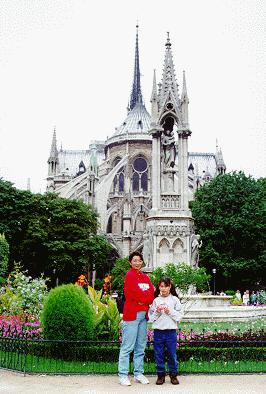Want better photos? Shred 'em to pieces!
I think we all learn a lot about photography by looking at how the people around us use cameras. My parents weren't into taking pictures, but whenever we went on vacation, I noticed when adults pulled out their cameras and what sort of things they took pictures of. Whenever I looked at a relative's photo album, I noticed they usually put a lot of background and a lot of headroom in their photos of people. The classic example is taking a vacation picture next to a scenic landscape or famous landmark that is much larger than the person in the picture, effectively dwarfing them. To make matters worse, the subject invariably stands far away from the camera which makes them look even smaller.
 Photo courtesy of Michiko Walraven
Photo courtesy of Michiko WalravenThe average size of cameras with a zoom lens has been shrinking for many years, so I assume that zoom lenses have become the norm. This is important for several reasons. If a person has a zoom lens, they usually use it (if you think I'm wrong about this, please reply). That means people are now used to cropping their photos in-camera.
Another reason why cameras with a zoom lens are important is because they help to overcome a cultural handicap - the personal bubble. Something we rarely think about is the space around us that we feel comfortable in. The size of the space is different for every culture and depends largely on the relationship you have with the people in close proximity to you. When your personal space is breached by a person uninvited, discomfort sets in. You may remember a time when you entered someone's personal bubble and they backed away even though you had minty-fresh breath.
There's a fascinating online dialogue that puts the American bubble at 2-3 feet. That may not seem like a lot when you're talking about snapping someone's picture, but if your camera has a wide angle lens, it can make your subject look like they're twice as far from you. Add a lot of distracting background and frame the person's head in the center of the picture (or lower), and you've probably got a photo with very little impact.
Back in college when I made my own prints in the darkroom, I was often criticized for cropping my photos. But for me, the decision to crop simply comes from wanting to emphasize the most interesting part of a photograph. Here's an example from a Chinese New Year parade:
 What's the most interesting part of this photograph? The crowd? They're too far away. The drummers? Probably not, since you can't see their face. I think the most dynamic part of this photo is the drum and the drumstick.
What's the most interesting part of this photograph? The crowd? They're too far away. The drummers? Probably not, since you can't see their face. I think the most dynamic part of this photo is the drum and the drumstick.
Everyone was marching by quickly, but I knew I had to take another photo. By moving in and focusing on the drummer's hands and sticks, I cropped out everything that wasn't important (in this rare instance, it was the people), I created a photo with greater visual impact than the mish-mash of the previous photo.
Now that digital camera sales have surpassed film camera sales, the imaging software market has become very lucrative and competitive. While doing research for this blog entry, I came across a Microsoft research paper that details the work being done to create software that actually crops a photo based on where in the picture a person gazes most intently. Andy Warhol was nearly right with his famous prediction. In the future, we won't all be famous, but we will be great artists...so long as we have the right software!




1 comment:
hi frank...
i very much like your blog...
easy & interesting conversation style and approach...
nice treatment of photography topics...
you've got a ton...! of great...! photography up there...!
i started mine a week ago...experimenting with style and approach...
now, how to promote and become visible...that's another matter...
BLOG: http://www.xanga.com/cgolesch
WEBSITE: http://www.cgolesch.com/index.html
thanks...christoph
Post a Comment